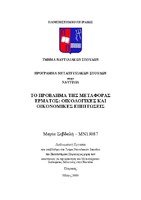Το πρόβλημα της μεταφοράς έρματος : οικολογικές και οικονομικές επιπτώσεις

Προβολή/
Λέξεις κλειδιά
Διαχείριση θαλασσίου έρματος ; Αλλόχθονα είδη ; Πλοία ; Περιβαλλοντικές επιπτώσεις ; Δίκαιο της θάλασσας ; Ναυτιλιακή οικονομικήΠερίληψη
It is well known that vessels use sea water for ballasting. This process is a structural function that allows them to sail unloaded. The management of Vessels’ Ballast Sea water has been recognized and identified by the shipping community, IMO and relative organizations, as an important pollutant issue. Biota that are transferred through ballast sea water, are discharged upon arrival thus creating serious environmental problems to the marine environment, by disrupting the existing ecological balance. This special kind of sea pollution causes enormous social, economic and environmental disturbance, degrading the local eco-systems and the adjacent human community. During the past 30 years, the Shipping Industry and relevant organizations are trying to find an effective single solution to this problem. EMSA and IMO have adopted relevant regulations, in order for ballast sea water to be treated, before discharge. This study analyzes and describes the need for on board ballast sea water treatment, as well as the various treating methods and systems. The IMO and other organizations demand the implementation of a number of regulations. They have been working on new ideas and their efficiency and availability. They also examine the necessary requirements of an on-board implementation system in connection to each ships specificities and and technical requirements. The analysis undertaken in this study aims at highlighting the main environmental issues and continues with a critical review of the main Alien Invasion Species (AIS) transported via ballast sea water. The second chapter looks into and analyzes various treatment methods and ballast water management issues, as well as several relevant ideas, in order o combat the AIS problem. IMO regulations’ have evolved through several conventions and revisions, an issue examined in the third chapter. The fourth and final chapter of this thesis strives to identify and highlight the on-board implementation issues of a treatment system. More specifically, what are the impacts on the environment and how should the international maritime community react? What are the obstacles regarding the adaptation of the various treatment systems? These are some of the main questions that this study attempts to answer, always in accordance to the contemporary international legal status, as well as the existing scientific and technological developments. If the AIS issue is to be resolved on a global scale, then the shipping industry will have to adopt treatment systems that have proven to be profitable and appropriate both for the ship-owners and the vessel itself.


